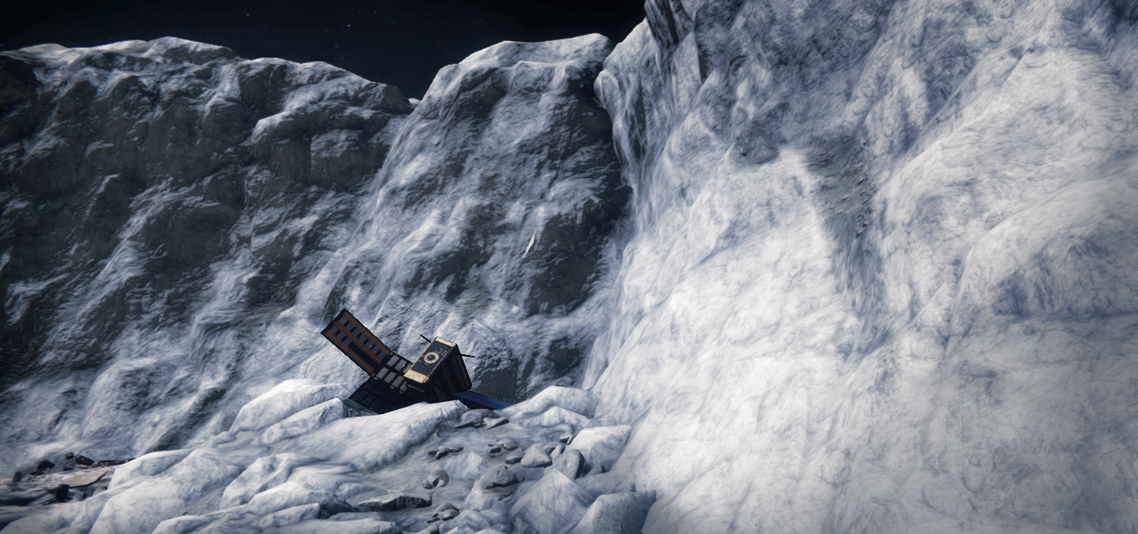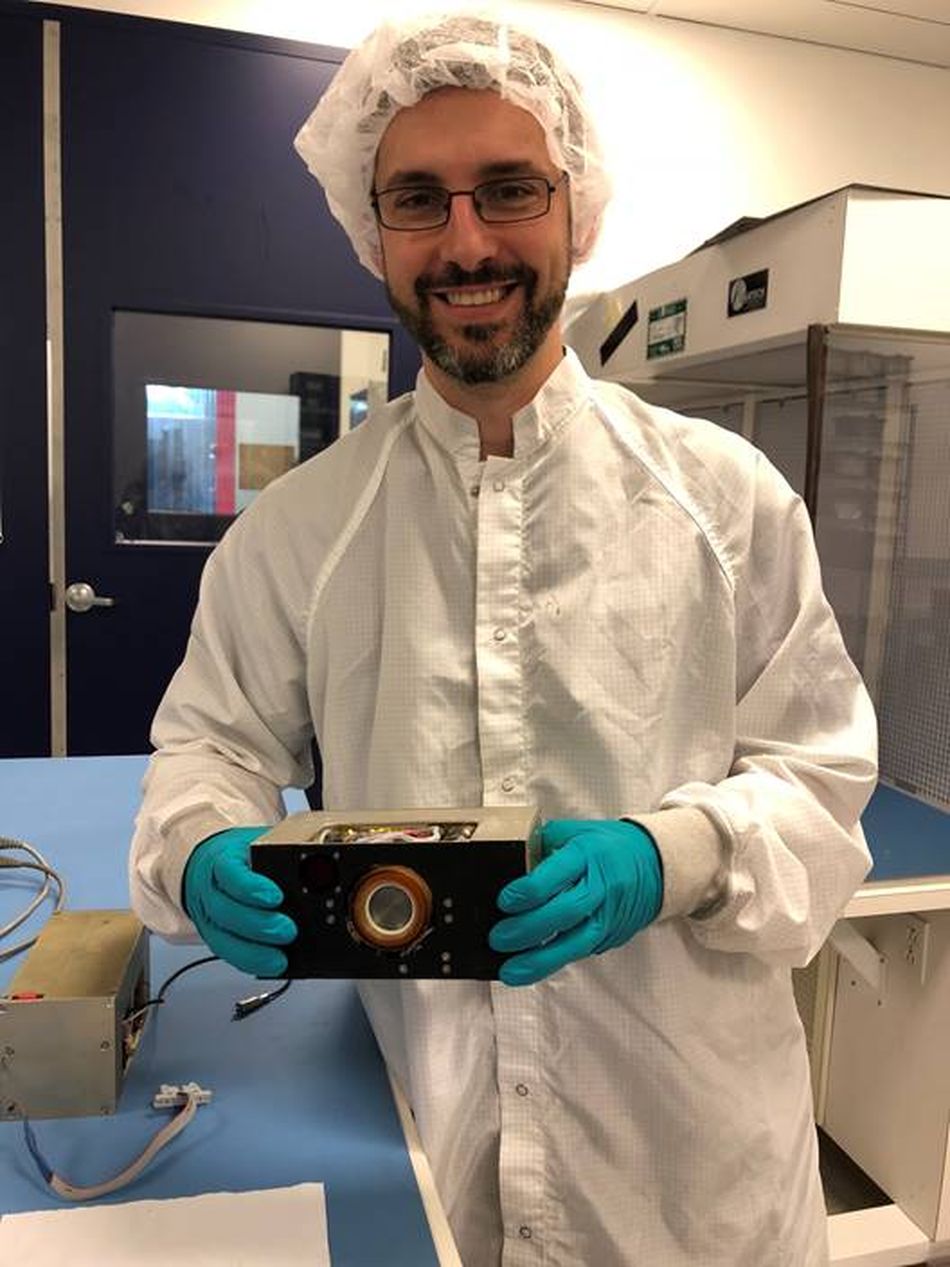
When Destiny 2 players touch down on the moon to explore Shadowkeep starting Oct. 1, they might also stumble across a piece of our IRL future buried in the airless wastes.
The Lunar Polar Hydrogen Mapper, which shortens to LunaH-Map, is one of 13 CubeSats that is scheduled to head to the moon in 2021 aboard Artemis-1. It’s one of several specialized satellites built to look for the presence of water-ice on the moon.
Once that mission is complete, LunaH-Map will crash somewhere in the Lunar South Pole – and that future crash site also happens to be tucked away somewhere in Shadowkeep‘s moon map.
It’s a little Easter egg for players to hunt down, one of the many that have graced the two Destiny games over the years. They’re added to encourage people to really explore every nook and cranny of the new spaces. Shadowkeep heads to the moon for the first time in Destiny 2 (it was a location in the first game), and a nod to NASA just made sense.
This one comes with a little bonus: an emblem, one of Destiny’s cosmetic items. Find and interact with the crash site, and you’ll unlock the below emblem, which is modeled after the LunaH-Map’s mission logo. Here’s a look at that logo:

And here’s a look at the actual emblem you can unlock. Don’t be alarmed by the “graphic content” warning; this is a perfectly safe image. I added that barrier just to protect anyone who would rather skip the more spoiler-y parts of this Easter egg.

Bungie didn’t tell us exactly where to look, but we already know the new season’s Shadowkeep content unfolds around the Lunar South Pole. You’ll want to keep your eyes open for the distinctive angular edges and black-and-yellow surfaces of the crashed satellite.
“As we know, the LunaH-Map spacecraft will crash into the moon at the end of its mission. After laying silent for many centuries, its remains are still there, for Guardians to discover,” Shadowkeep art lead Rob Adams said in a statement provided to Mashable. “Anyone exploring the Moon will have a chance at stumbling across this curious piece of pre-Golden Age human exploration history.”
Here’s a couple images of what a deployed LunaH-Map would look like, compliments of NASA.

LunaH-Map spacecraft with solar arrays deployed

LunaH-Map spacecraft with solar arrays deployed
It’s a relatively tiny thing, weighing just 30 pounds and measuring out to roughly 4 in. x 8 in. x 12 in. Once fully deployed, LunaH-Map will circle the moon in a polar orbit, piecing together a high resolution map and scanning the region for signs of hydrogen up to one meter beneath the surface of the moon.
An ASU landing page for the LunaH-Map mission explains how the aim is “to discover how much water-ice is hidden in the permanently shadowed regions of the Moon.” The satellite, which is roughly the size of a “large shoebox,” is fitted with a neutron spectrometer designed to help the team see into those darkened areas.
There’s also a bigger goal at play here: to show NASA how a small and nimble scientific vessel like LunaH-Map can tag along as a complement to larger and more elaborate missions.
“If successful, LunaH-map will significantly add to our knowledge of how water formed and evolved at the poles, and will help future missions that wish to exploit lunar water,” the mission profile reads. “LunaH-Map will demonstrate that small, highly focused, science-driven, agile spacecraft can serve as secondary payloads on bigger NASA missions and will enhance the primary mission science… or even make unique discoveries of their own.”
LunaH-Map will provide a high resolution map of the abundance and distribution of hydrogen rich compounds, like water, in this region of the Moon and expand on the less accurate maps made by previous missions. This information may then be used to improve scientific understanding of how water is created and spread throughout the Solar System or used by future manned missions for life support and fuel production.
Here’s a look at the LunaH-Map in its stowed configuration, with a ruler included for scale.

In other words, don’t expect to find some big, messy crash site. The wreckage of this diminutive satellite is tucked away on the surface in a less-than-obvious place. Players will likely find it quickly – we Destiny fans are a dedicated bunch – but this is an Easter egg. It’s not meant to be a gimme.
If you want an even more specific peek, here’s what the LunaH-Map crash site looks like in-game. The screenshot isn’t enough to tell you exactly where to find it, but it should put you on the right track.

The Bungie-NASA team-up came about because, well, lots and lots of people play Destiny, and that includes NASA employees. One of those people, Dr. Craig Hardgrove, is the Principal Investigator for the LunaH-Map mission. He’s been working on the project at Arizona State University since 2015, when NASA awarded the school with a contract to develop the satellite.

Dr. Hardgrove holding the flight LunaH-Map propulsion system. The propulsion system is very low thrust but is incredibly efficient. Over time, the low thrust is enough to allow the LunaH-Map spacecraft to enter lunar orbit and map south pole ice deposits.

Flight Miniature Neutron Spectrometer (Mini-NS) for LunaH-Map. The Mini-NS is the only scientific instrument on the spacecraft and will be used to identify enrichments of ice buried at the lunar south pole.
Dr. Hardgrove’s work found its way into Shadowkeep thanks to Rob Adams, the art lead for the new expansion at Bungie. The two are friends, and together – along with the talented team at Bungie – they hatched this plan for repping a NASA mission inside the game. Hardgrove is also hoping to see some kind of Destiny tribute head to space when the real LunaH-Map mission launches in 2021, but that’s still a ways off.
No matter what happens, he and his whole team at ASU are thrilled to see the fruits of their efforts appearing in the most unexpected of places: a video game about alien visitors and space magic.

Dr. Hardgrove (far right) with the LunaH-Map team at ASU.
Destiny’s connection to NASA became more concrete earlier in 2019 when astronomers discovered an anomaly beneath the Lunar South Pole. Shadowkeep had only just been announced, and fans, prompted by Destiny 2‘s Twitter feed, leapt on the opportunity to make Destiny jokes.
History repeated on Saturday when NASA tweeted out a bit of hype for the Artemis mission, led by a GIF exclaiming “We’re going to the moon to stay.” Destiny fans hopped into the fray once again, no doubt puzzling NASA’s social team with an avalanche of “moon’s haunted” jokes.
Shadowkeep kicks off a new era in Destiny 2 starting Oct. 1 at 1:00 p.m. ET. Launching alongside the new content season is Destiny 2: New Light, a free-to-play version of the game that gives players access to all of the Year 1 content released from Sept. 6, 2017 until Year 2 began with Forsaken in Sept. 2018.
You can find a full rundown of what’s included in New Light, which will be available for PC, PlayStation 4, and Xbox One, right here.
read more at https://mashable.com/?utm_campaign=Mash-Prod-RSS-Feedburner-All-Partial&utm_cid=Mash-Prod-RSS-Feedburner-All-Partial by Adam Rosenberg
Digital marketing







